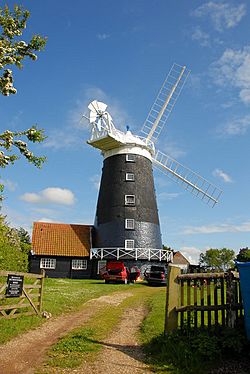Burnham Overy Staithe Windmill facts for kids
Quick facts for kids Burnham Overy Staithe Windmill |
|
|---|---|

Burnham Overy Staithe Mill
|
|
| Origin | |
| Mill name | Burnham Overy Staithe Mill |
| Coordinates | 52°57′35″N 0°44′05″E / 52.95972°N 0.73472°E |
| Operator(s) | National Trust |
| Year built | 1816 |
| Information | |
| Purpose | Corn mill |
| Type | Tower mill |
| Storeys | Six storeys |
| No. of sails | Four sails |
| Type of sails | Double patent sails |
| Windshaft | Cast iron |
| Winding | Fantail |
| Fantail blades | Six blades |
| No. of pairs of millstones | Three pairs |
Have you ever seen a giant spinning tower that used to grind grain? That's what the Burnham Overy Staithe Windmill is! It's a special old building in Burnham Overy Staithe, Norfolk, England. This amazing tower mill is so important that it's a Grade II* listed building. Today, you can even stay inside it, as it has been turned into a unique holiday home!
Contents
The Mill's Story
Building and Early Owners
The Burnham Overy Staithe Mill was built in 1816. It was made for a miller named Edmund Savory. He already ran a watermill nearby on the River Burn.
Edmund Savory worked the windmill until he passed away in 1827. His son, John Savory, then took over the mill. John worked hard, keeping the mill running until he died in 1863. After him, his son, also named John, became the miller.
Changes and Challenges
In 1888, the mill was put up for sale. It was part of a big property. This included a steam mill and the watermill, along with the windmill. There were also buildings for making malt and storing grain. But the property didn't sell right away.
John Savory continued to run the mill until 1900. Then, it was sold to Sidney Dewing. Later, in 1910, Sidney Everett bought the mill.
The Mill's Last Working Days
In 1914, something called a "tailwind" happened to the mill. This means the wind blew from the wrong direction. The mill stopped working for good in 1919.
In 1926, an architect named Hugh Hughes bought the mill. By this time, most of the inside machinery was gone. Hugh Hughes decided to turn the old mill into a place where people could stay for holidays.
Restoring the Mill
In 1957, some important repair work was done. A new top part, called a cap, was added. New wooden arms, called stocks, and sails were put on. The platform around the mill was also fixed.
In 1958, the mill was given to the National Trust. This is a group that looks after special places. In 1978, the National Trust wanted to make the mill work again. They planned to add new parts inside and make a shop. But local people didn't agree with all the plans. The local council said no because the roads nearby were too small for many visitors.
The inside of the mill was updated in 1981. This was to make sure it met fire safety rules. In 1983, the old sails and stocks were taken off. New, very long stocks were put on in 1985. The next day, four new sails were added. These new parts cost a lot of money, but they made the mill look great again!
How the Mill Works
Burnham Overy Staithe Mill is a six-storey tower mill. It has a special top part called an ogee cap. This cap has a walkway, or gallery, around it. A fantail helps the cap turn to face the wind.
The mill has four Double Patent sails. These sails are carried on a strong cast-iron windshaft. The windshaft also has a large wooden brake wheel. This wheel used to power three pairs of millstones. These stones would grind grain into flour.
Who Ran the Mill?
Here are the people who were in charge of the mill over the years:
- Edmund Savory (1816-1827)
- John Savory (1827-1863)
- John Savory Jr (1863-1900)
- Sidney Dewing (1900-1910)
- Sidney Everitt (1910-1921)
Visiting the Mill
Today, you can rent Burnham Overy Staithe Mill for a holiday. It's a unique place to stay!

